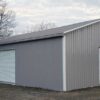Steel varies dramatically in quality and strength. When it comes to engineering purposes, the specifications regarding “yield strength” make a big difference in performance and longevity for projects. For structures meant to protect life and property, only the highest yield strength should be used, because it’s engineered to take the most that happenstance and the elements can hurl at it.
Yield Strength: Defined
Let’s do metallurgical engineering 101. The “stress-strain curve” is a metric that looks at the relationship between stress and strain on a metal. Basically, the metal has a load applied to it – the stress – and if it can return to its original shape after this stress is removed, then that’s elastic deformation and is sustainable. But, if a load is too heavy or comes with too much force, that “strain” causes plastic deformation – a permanent deformation, such as buckling, bending, or breaking. That’s the no-go point where it “yields” to the stresses placed upon it, and that’s the point where it becomes inadequate for the job.
Plastic deformation is that point when something no longer returns to its proper shape after bearing a load.
An Everyday Example of Yield Strength
Think of it like the hood of a car and how, eventually, it will buckle under a certain amount of weight and pressure. A parent getting ready for a day of running around may set their baby carrier upon the hood, and the hood may bend a bit under the baby and carrier, but when the carrier is put inside the car, the hood returns to its proper shape.
This is because the weight of the baby plus carrier hasn’t exceeded the car hood’s yield strength.
But if a 12-year-old boy jumps over a wall and lands on the car’s hood, then his weight plus the force of the jump means the car now has a huge dent on the hood.
With the boy’s heavy landing, the yield strength was exceeded, and plastic deformation occurred and now the hood of the car needs a visit to a body shop so the dents can be hammered out. Unfortunately, it likely won’t ever have the same yield strength after its repair.
Yield strength is affected by things like torsion stress, compression, bending, and other forces that amplify stress caused by weight alone.
All Stresses Are Not Equal
The example of the 12-year-old jumping on a car hood is an good one for illustrating the differences between types of loads or forces on metals.
A dead load means the load or force is a constant or steadily applied load, like the baby in the infant carrier gently placed upon the car hood.
A live load is a sudden shock load or a load where there are slow or fast changes in its magnitude, like the boy jumping on the hood of the car, where his velocity intensifies the load’s impact.
Why Yield Strength Matters
Taken into the real world, that velocity-plus-load aspect of engineering and yield strength is important. It’s the difference between that old oak tree branch crashing through the sunroom’s roof or just making a bad mess of the yard. It’s the difference between large hail denting a roof’s metal panels or not.
It’s also the difference between a structure still standing after a hurricane versus one leveled by wind and storm surge. It is the difference between a large tree going through a structure to the ground, or the structure stopping the tree before it does major damage.
Visual Example of The Importance of Yield Strength

All Steel is NOT CREATED EQUAL
Steel is strengthened through a variety of processes. Everything from the removal of impurities to the addition of alloys changes steel’s strength. The steel you get in a dinner spoon isn’t the same as structural steel used for building a bridge. Hence, you need to look beyond advertising copy that tells you that shed or carport you’re interested in is “100% steel.”
Ever bought a bargain-bin screwdriver then had the tip chip or break off when using it? That’s a low-yield strength steel that has no business being used for a torque-force tool like a screwdriver.
Figuring Out the Yield Strength
The higher the yielding ability of steel is, the more the steel can absorb through a shock or sudden load – and that’s what makes it safer to use when it comes to metal structures that may have people or property inside.
The steel used for a patio table would not qualify for structural uses, for instance. To determine yield strength, a variety of methods can be used. Among them are mathematical calculations engineers use for determining strength. Then there are also physical stress tests done by manufacturers and other metallurgical professionals, where increasing loads and forces are applied to the steel as they record both the elastic and plastic deformation stages for yield and shear strength, as well as tensile strength.
Understanding the actual yield strength of a metal is just half the story. The other half are the engineers who determine the required yield strength needed for steel, depending on the purposes for which it’s being used. This is the minimum yield strength needed for a project. Anything less than “minimum yield” strength isn’t just a compromise, it’s hazardous.
For products like steel building frames and panels, these best practices for yield strengths are outlined in the International Code Council’s building standards. These are then weighted according to regional hazards, like hurricane-force winds, earthquakes, wildfires, high snow loads, unstable soil situations, probability of tornados, and so on.
Each of these elemental forces can be expressed as a mathematical equation and, from there, engineers deduce the minimum yield strength required for a structure to remain standing when facing those forces. Curious to see some of the equations in question? ScienceDirect has all the math for you on deducing minimum yield strength.
Choose Only the Highest Yield Strength
When you research your steel building project, look for a company that offers high yield strength steel. Like the spoon and bridge steel mentioned above, not all steel is created equal. Often times, lower prices are had by virtue of lower quality steel.
For example, Absolute Steel is an American manufacturer of steel buildings. Those structures are used by the Department of Homeland Security and throughout the American Armed Forces because they are easy to assemble properly, but also because they’re built with highest yield strength. If you purchase your building system from the manufacturer who controls the steel and the overall manufacturing process, you have a better chance of knowing what is under the hood, so to speak, of your building.
Beyond just the frame, ensure any metal panels for your building (wall and/or roof) meet the same criteria. Again using Absolute Steel as an example, their panels have a yield strength of 80,000 pounds, or 40 tons of pressure per square inch. The steel building frames are manufactured with 14- and 15-gauge steel tubing. Base rails, side walls, peaks, and eaves all boast a minimum yield strength of 55,000 to 65,000 psi. They also apply a G90 galvanized protective layer, which exceeds the industry standard of G60. On top of that goes a patented anti-corrosion clearcoat. This is an example of a company with quality steel.



